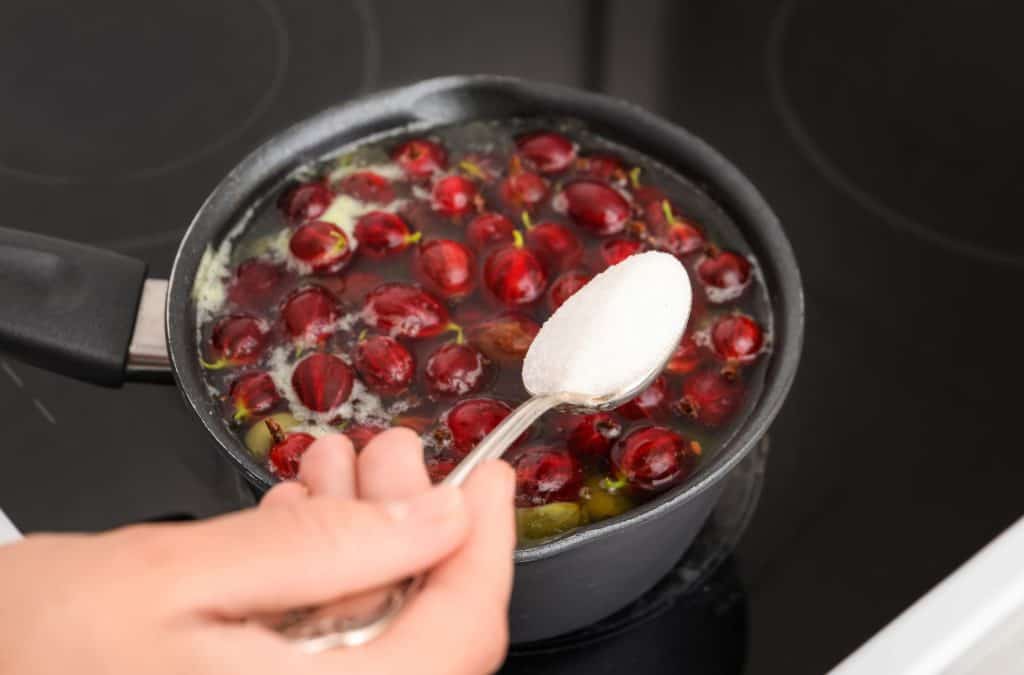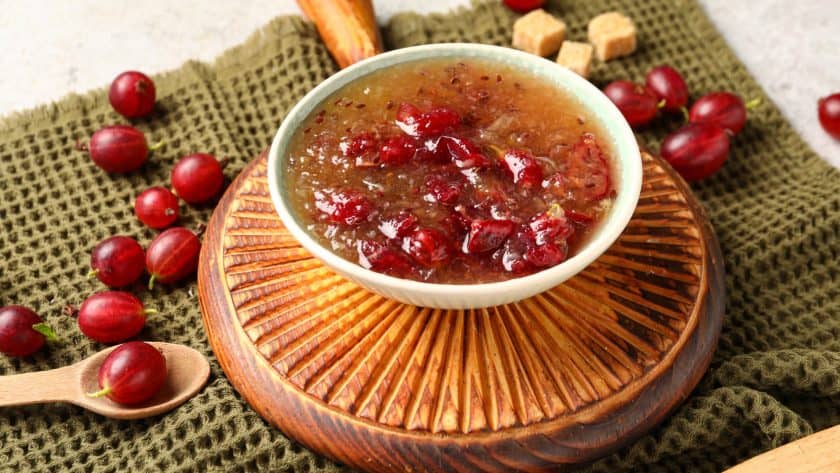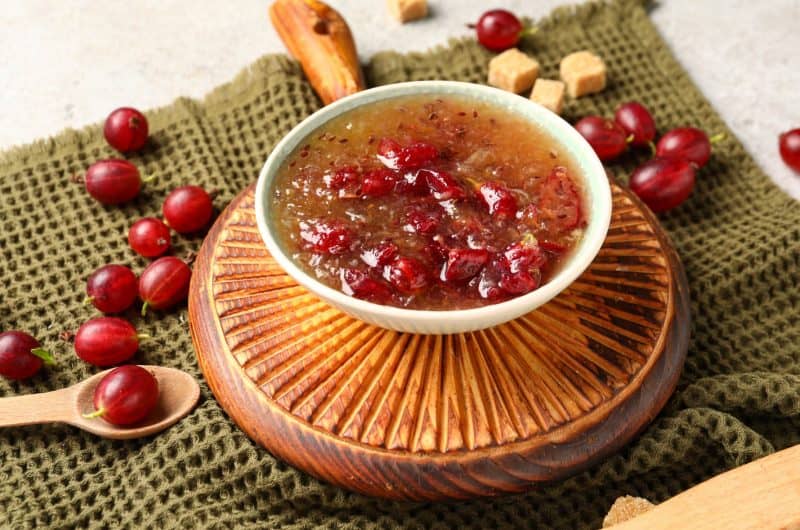the first time I made gooseberry jam, it looked more like swamp jelly than anything Mary Berry would serve with her scones. I’d underestimated just how tart gooseberries can be—and overboiled it in my panic to make it set. The result? A jam that could probably patch a roof.
So I went back, tested again (twice, actually), and finally nailed that perfect balance of tart and sweet. The key was patience—and a cooler boil. If you’ve ever been intimidated by jam-making, let me show you how I tamed these feisty berries into a glossy, spoonable preserve that tastes like summer bottled up.
WHY THIS ONE WORKS SO WELL
Gooseberries are naturally high in pectin, which means you don’t need any fancy setting agents—just fruit, sugar, and a bit of water. Most recipes rush the cooking, but the trick is a slow simmer first, letting the berries burst gently before adding sugar. It keeps that bright green color and prevents a rubbery texture.
I also found that a brief 5-minute rest before jarring helps the fruit stay evenly suspended rather than sinking to the bottom. Little detail, big payoff.
INGREDIENTS + WHY THEY MATTER
- Fresh Gooseberries (1kg / 2.2 lbs) – Green ones give a tart, traditional jam; red ones are sweeter and softer. I once mixed both—it made the prettiest blush-pink shade.
- Granulated Sugar (900g / 4½ cups) – Standard sugar works perfectly; no need for jam sugar because gooseberries have loads of pectin.
- Water (150ml / ½ cup) – Just enough to soften the berries before they release their juice.
- Optional: Lemon Juice (1 tbsp) – Adds a clean brightness, especially if your berries are very ripe.
MAKING IT YOURS (WITHOUT RUINING IT)
- Elderflower Twist – Add 2 tbsp elderflower cordial before boiling; it turns this into a summer dream.
- Red Gooseberries – Naturally sweeter and less tart—great if serving with cakes.
- Ginger Warmth – A tiny pinch (⅛ tsp) of ground ginger brings depth, but more than that overpowers the fruit.
- Sugar Swap – I tried light brown sugar once; it dulled the color, so I’d stick with white.
MISTAKES I’VE MADE (AND HOW TO AVOID THEM)
| What Went Wrong | Why It Happens | How to Fix It |
|---|---|---|
| Jam turned rubbery | Boiled too long at high heat | Boil rapidly for no more than 10–12 minutes |
| Fruit sank to the bottom | Didn’t rest before jarring | Let it rest 5 mins off the heat |
| Jam didn’t set | Didn’t reach 105°C (220°F) | Use a thermometer or the wrinkle test on a cold plate |
HOW TO MAKE MARY BERRY’S GOOSEBERRY JAM
- Prep the Fruit
Wash, top, and tail your gooseberries—yes, both ends matter. (Once I skipped this and ended up with chewy stems in every bite.) - Soften the Berries
Add them to a large pan with 150ml water. Simmer gently for 10–15 minutes until they burst and turn pulpy. - Add the Sugar
Stir in sugar over low heat until dissolved—don’t rush this bit or you’ll end up with gritty jam. - Boil to Set
Turn up the heat and boil fast for 10–12 minutes. Skim any foam for a clear finish. Test for set with a chilled plate or aim for 105°C. - Rest and Jar
Let it rest 5 minutes so the fruit settles evenly. Ladle into warm, sterilized jars and seal. - Label and Store
Cool completely, then label with date and batch (I always write “Batch 2 – better set!” for my own amusement).

TIPS FROM MY KITCHEN
- Chill your testing plate before you start—saves you scrambling mid-boil.
- Use a metal spoon for stirring; wooden ones hold moisture and can dull the set.
- If you’re using a fan oven to sterilize jars, pull them out just before filling—still hot, never cold.
- I prefer smaller jars; they cool quicker and are easier to gift.
STORAGE + SERVING
- Shelf Life: Up to 12 months unopened in a cool, dark cupboard.
- Once Opened: Keep refrigerated and use within 3–4 weeks.
- Freezing: You can freeze unopened jars for up to 6 months—just leave a little headspace.
- Serve With: Toast, scones, Victoria sponge, or (my favourite) a thick wedge of Brie.
FAQ
Q1: Can I make gooseberry jam without a jam thermometer?
Absolutely. The old-fashioned “wrinkle test” works perfectly. Spoon a little jam onto a chilled plate, wait 30 seconds, then push it gently—if it wrinkles, it’s ready. If it slides smoothly, keep boiling for another 2–3 minutes and test again.
Q2: What colour should gooseberry jam be when it’s done?
Green gooseberries turn a soft golden-green when fully cooked, while red varieties shift to a deep rose or ruby hue. The jam should look glossy, not matte, and fall from the spoon in a thick sheet—not in drips.
Q3: Can I use frozen gooseberries to make jam?
Yes, frozen gooseberries are a brilliant shortcut. Thaw them overnight in the fridge and drain off any extra liquid before cooking. They may release more water, so you might need to boil 2–3 minutes longer for a firm set.
Q4: Why didn’t my gooseberry jam set properly?
This usually means the mixture didn’t reach the magic setting point of 105°C (220°F). Gooseberries are naturally high in pectin, so you don’t need to add any, but temperature matters. Try reheating the jam gently and rechecking with a chilled-plate test or thermometer.
Q5: Do I need to top and tail gooseberries before making jam?
Yes—always remove the stems and blossom ends. It’s the fiddly part, but skipping it leaves tough bits in your jam. I usually do it in front of the TV with a podcast and a good paring knife.
Q6: Can I reduce the sugar in gooseberry jam?
Not really. Sugar isn’t just for sweetness—it helps the jam set and preserves it safely. If you want a slightly tarter version, use red gooseberries or add a squeeze of lemon juice instead of cutting sugar.
Q7: How long does homemade gooseberry jam last?
When properly sealed and stored in a cool, dark cupboard, gooseberry jam keeps beautifully for up to 12 months. Once opened, refrigerate and enjoy within 3–4 weeks.
Q8: Can I freeze gooseberry jam?
Yes. Make sure your jars are freezer-safe and leave a little space at the top for expansion. Thaw in the fridge overnight before using—texture stays wonderfully smooth.
Q9: What do you serve gooseberry jam with?
Everything from buttered toast to Victoria sponge layers. It’s gorgeous with scones and clotted cream, stirred into porridge, or dolloped alongside goat’s cheese on a cheeseboard. I also love it with roast pork—it cuts through the richness beautifully.
Q10: Can I mix gooseberries with other fruits?
Definitely. Apple or elderflower pair especially well. Gooseberry-apple jam adds body and a gentle sweetness, while elderflower cordial turns it into a fragrant, summery preserve.
Other Recipes You May Like
- Mary Berry Apricot Jam Recipe
- Mary Berry Strawberry Jam Recipe
- Mary Berry Gooseberry And Elderflower Fool
Mary Berry Gooseberry Jam – Tangy, Old-Fashioned, and Foolproof
Course: PreservesCuisine: British5-6 jars
servings20
minutes30
minutes52
kcalIngredients
1kg gooseberries, topped and tailed
900g granulated sugar
150ml water
(Optional) 1 tbsp lemon juice
Directions
- Wash and top/tail the gooseberries.
- Place in a large pan with water; simmer 10–15 mins until soft.
- Add sugar, stir until dissolved.
- Boil rapidly 10–12 mins to 105°C or until wrinkle test passes.
- Rest 5 mins, then ladle into sterilized jars.
- Seal, cool, and label.

